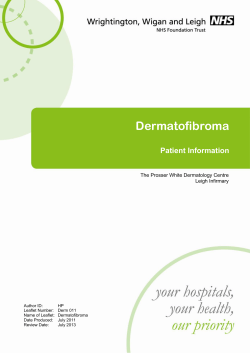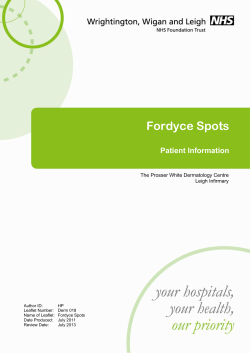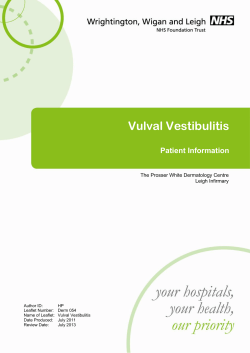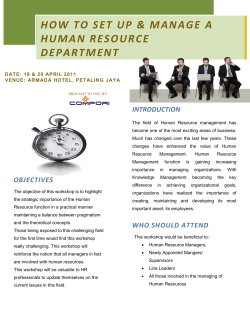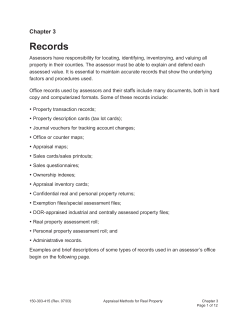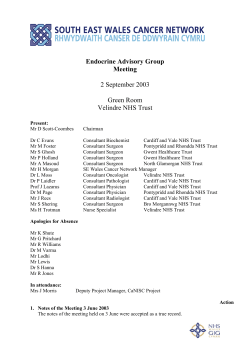
HTA in the UK: 10 years experience of NICE Francoise Cluzeau NICE International
HTA in the UK: 10 years experience of NICE Francoise Cluzeau NICE International Some background: the NHS in the United Kingdom • • • • UK NHS is free, largely, at the point of delivery and all citizens are covered Annual budget of £100 billion (about 160 Billion US$) It is not perfect; universal coverage with fixed resources involves compromises…But it provides a good level of cover Private insurance in the UK approx. 10% and shrinking The NHS in the late 90s… • • • • No quality standards Lack of national guidance for professionals Unexplained/unpopular variation in care Expensive new technologies 1997 - Government white paper ‘A new National Institute for Clinical Excellence will be established to give new coherence and prominence to information about clinical and cost-effectiveness.’ So what is NICE? The National Institute for Health & Clinical Excellence (NICE) is the independent organisation responsible for providing national guidance on the promotion of good health and the prevention and treatment of ill health – – – – – Special Health Authority – part of NHS Budget of £61m pa, including £21m for NHS Evidence Projected to be £87m in 2011-2012 ~400 staff Working with over 2,000 experts –physicians, nurses, health economists, clinical epidemiologists, statisticians, lay peopleacross the UK – Partner of EUnetHTA Other HTA programmes in the UK NICE is not the only organisation that conducts HTA in the UK • • • • The NIHR Coordinating Centre for HTA (NCCHTA) The Centre for Reviews & Dissemination (CRD) Scotland (NHS Quality Improvement ) Wales (Medicines Strategy Group) Principles of NICE guidance • Robust – underpinned by a comprehensive and sound evidence base • Inclusive – Genuine consultation of stakeholders and expert involvement/ contestability • Transparent – evidence and conclusions in the public domain • Independent – developed by external advisory committees What technologies? • Pharmaceuticals (e.g. beta-interferon for MS) • Medical devices (e.g. hearing aids, inhalers; insulin pumps) • Diagnostics (e.g. liquid-based cytology) • Procedures (e.g. surgery for morbid obesity, repairing hernias) • Health promotion tools (e.g. patient education models for diabetes) Two types of TAs Multiple Technology Appraisal (MTA) – run since 1999 – takes ~14 months – Reviews, complex appraisals, classes of technologies Single Technology Appraisal (STA) – run since 2006 – takes ~35 weeks – Single technologies, single indications, close to introduction to the NHS All HTA recommendations to be implemented within 3 months of publication Independent assessment Submissions from consultees 4 weeks Consultation on evidence 13 weeks 1st Committee meeting →preliminary recommendations 14 weeks Referral MTA 4 weeks Review Consultation on preliminary recommendations Publication Appeal (or not) [14 months] 2st Committee meeting → final guidance Evidence review Evidence submission from manufacturer ‘No’ ‘restrictive’ 8 weeks Committee meeting Preliminary recommendations 8 weeks 4 weeks STA Referral ‘Yes’ Consultation Review Final guidance Publication Appeal (or not) [ 7-9 months] Committee meeting Independent academic groups • Commissioned through the NCCHTA (National Coordinating Centre for Health Technology Assessment, part of NHS R&D) – independent from NICE • Carry out systematic review and develop economic model (MTA) • Critique the evidence submitted by manufacturer (STA) • Presented in report to the Appraisal Committee • Present at the Committee meeting to answer questions Independent academic centres • • • • • • • Health Economics Research Unit and Health Services Research Unit University of Aberdeen Liverpool Reviews & Implementation Group, University of Liverpool NHS Centre for Reviews and Dissemination, University of York Peninsula Technology Assessment Group (PenTAG), Peninsula Medical School, Universities of Exeter and Plymouth School of Health and Related Research (ScHARR), University of Sheffield Southampton Health Technology Assessment Centre (SHTAC), University of Southampton West Midlands HTA Collaboration, Department of Public Health and Epidemiology, University of Birmingham Appraisal Committees • Four Standing Committees, working across the whole spectrum of interventions and conditions • 32 members drawn from Primary Care, Secondary Care, Royal Colleges, Patient Groups, Health Economists, NHS Management, Public Health, Healthcare Industries, Biostatisticians • Receive all evidence, expert statements and comments • Members with a conflict of interest for a particular drug cannot participate in an appraisal including that drug Consultees and Commentators (stakeholders) • Consultees – manufacturer/ sponsor; national professional and patient organisations; NHS - Primary Care Trusts, DH • Commentators – e.g. Comparator manufacturers; relevant research groups • All provide comments on draft scope, the evidence, draft guidance • Consultees also submit evidence and have the right to appeal The need for economic assessment • Recognises the reality of fixed NHS resources – and brings this to the attention of the public • Exposes the opportunity cost of new interventions • Enables consistency in investment – and disinvestment – decisions • Helps to direct innovation into those areas regarded as priorities by the health system • Brings together all available data on the effectiveness, resource use, costs, and outcomes • Allows extrapolation to the long term if necessary • Allows the consideration of uncertainty Measuring quality of life - Utilities Quality of life questionnaires included in clinical trials – eg EQ 5D - mobility - self care - pain and discomfort - usual activities - depression and anxiety • Single index utility values established by asking people to “value” a description of a particular health state • A utility value of 0.2 = people would give up 20% of their length of life to avoid the particular health state Why NICE doesn’t have a fixed cost effectiveness threshold? Costeffectiveness Extent of uncertainty NICE Making Judgements DECISIONS Potential benefits of Innovation Equality & Diversity legislation Social Value Judgements Technology Appraisals - breakdown by disease areas Cancer Cardiov ascular Central nerv ous sy stem Digestiv e sy stem Endocrine, nutritional and metabolic Ey e Gy necology , pregnancy and birth Infection Infectious diseases Injuries Mental health and behav ioural conditions Metabolic and Endocrine Mouth and dental Musculoskeletal Respiratory Skin Surgical procedures Urogenital Breakdown of recommendations Comparison of all vs cancer technologies 60 50 40 all % cancer % 30 20 10 0 yes partical yes OIR not recommended Technology appraisals: outputs Technology appraisal decisions Decision Number Percent Unrestricted 98 29% ‘Yes’ with restrictions’ 188 55% Only in Research 21 6% Not recommended 31 9% Non-submission 4 1% Total 342 100% 84% of our advice recommends use… 342 individual recommendations in 160 technology appraisals Statin uptake In the press Not everybody is happy with our decisions Alzheimer's Society, London 2006 Vol 372, Aug 23, 2008 End of life drugs: New development • Concern that life-extending treatments (e.g. cancer) are undervalued by the appraisal process • And… Almost 1 in 3 drugs trough STA process are cancer drugs • In January 2009 NICE issued supplementary advice to Appraisal Committees • Sets out criteria for appraisal of end of life treatment with an incremental cost effectiveness ratio (ICER) above the upper end of the range normally approved by the Appraisal Committees Ongoing issue: the threshold • Should the QALY threshold be raised? ØYes - NICE should base its decisions on the public’s willingness to pay. ØNo - The threshold should be based on opportunity costs in terms of displaced interventions • NICE should develop a disinvestment programme based on identifying treatments with poor cost effectiveness • Ongoing work: the ‘threshold-searcher’ Recent developments in technology appraisal: pricing and access • The UK’s voluntary Pharmaceutical Price Regulation Scheme (PPRS) has been revised in 2009 with two new elements to better reflect value in the price of drugs: • Flexible pricing: will allow a company to increase or decrease its original list price when new evidence emerges concerning the drug’s efficacy or risks, or a different indication is developed; • Patient access schemes: can facilitate patient access for medicines that were not initially found to be cost- or clinically effective by NICE. “NICE has been widely debated and often critized since its inception in 1999. However it can claim several major achievements and still represents one of the more sophisticated attempts to integrate HTA into the decision making process” Michael Drummond & Corinna Serenson, Value in Health, 2009
© Copyright 2025



